A Roman Tribune plays the role of Columbo in the most famous game of “CLUE” known to the world, called – “Where’s the body?”

We all know the story of the empty tomb – the excited women – the missing “Messiah”. That is – we all know it from that side of the tomb.
But, what was it like from the other side? The Roman side of an empty grave? The tomb that was sealed with the Roman Governor’s seal and guarded with Roman soldiers?
‘RISEN’ has taken up the challenge in resolving the mystery.
“I’m yet sticky with filth.”
Thus said the Tribune Clavius when summoned to Pontius Pilate. And thus sets our understanding of Clavius’s soul – ‘yet sticky with filth’.
Clavius, a role portrayed with depth and sensitivity by Joseph Fiennes, is accustomed to brutality, bloody combat and death, but not without a price. He is drained, depleted, battle weary and emotionally dead. In the opening battle scene, he brutally kills a Jewish rebel leader, named Barabbas. (“Barabbas”? Is that coincidental or is that God’s way of evening up the score?) The constant gore and butchery of quelling those pesky Jewish insurrections in a remote, desolate land far from the ‘action’ of Rome, has taken its toll, robbing him of hope and peace, leaving him numb and yearning for nothing more than…
“…a day without death.”
Upon returning to the Antonio Fortress, (interestingly placed below the old city of Jerusalem), his day isn’t quite over yet. He is summoned by the Governor, something that happens all too often. It seems Pilate “has a situation” and he needs Clavius to tidy up the loose ends. Those “raving Jews” wanted a man named Yeshua, who claimed to be the “messiah” disposed of.
“I had to crucify him,” Pilate says almost regrettably, (a sentiment one finds hard to accept knowing the history of this brutal dictator who crucified and slaughtered thousands).
Clavius ensures that Yeshua is dead and securely buried in a sealed tomb with Roman guards posted.
End of story – right?
No – of course not – it’s only the beginning. The inevitable happens – the body doesn’t remain in the tomb.
Let the games begin – after all – we can’t have dead people walking about – can we?
 “We must find the body,” Pilate raves. “Find the corpse of this cursed Yeshua before it rots.”
“We must find the body,” Pilate raves. “Find the corpse of this cursed Yeshua before it rots.”
Exploded frayed ropes – two anemic looking drunken guards – discarded, bloody grave clothes – a stone tossed aside – lies and bribes from the Sanhedrin – all lead to …nothing…no body.
Does Clavius ever find his missing body? Oh yes – with a little twisting of the arm and a bag of coins, Yeshua’s disciples are found. And they did, in fact, have the body with them.
Only – the body isn’t dead, but is very much alive, and in a scene straight out of The Twilight Zone, this hardened Roman warrior melts into the stone wall as he encounters the true power of God in the flesh. This moment just happens to coincide with the arrival of ‘doubting’ Thomas. While he probes the wounds in the wrists and side of the Messiah, the eyes of a smiling Yeshua probe deep into the soul of the Tribune.
What do you do when you encounter the impossible? He does the only thing he can do – he follows the walking dead man. In this case it means following the followers of Yeshua, like a stray, lost dog; finding acceptance among them, and ultimately – friendship.
When finally he is alone with the murdered, living man, Yeshua asks him what he seeks in life, and then answers his own question:
“A day with no death?”
Clavius leaves all behind – to travel a new road – to places we know not of – but with a new found peace, after witnessing the ascension of Jesus and hearing His great commission.
We are set up for a sequel – as we know not where Clavius is going or what roads lie ahead for him.
‘Risen’ is excellent historical fiction that intertwines Biblical scripture with “what might have been”. The historical is historical and the fiction is fiction – and in those scenes where the two intermix, the purity of the Scriptures was not compromised. One area where liberties were taken, was the reference to Mary Magdalene being a quite popular “woman of the streets”. This was based on church tradition and finds no merit in Scripture.
 The battle scene, Roman soldier dress, weapons and warfare was as realistic as ever shown, and Jewish culture along with Sanhedrin attire and demeanors were portrayed as accurately as history tells us.
The battle scene, Roman soldier dress, weapons and warfare was as realistic as ever shown, and Jewish culture along with Sanhedrin attire and demeanors were portrayed as accurately as history tells us.
The portrayal of crucifixions reflected the known information of such executions.
Jesus is shown smiling, laughing and gracious. He is a miracle worker and His disciples love Him as their father and leader. When Bartholomew (who would have fit right in on a California beach as a surfer dude) is threatened with crucifixion himself, he spreads open his arms and laughingly replies: “I would happily submit”.
Clavius sums it all up by leaving his life behind, saying “I believe. I can never be the same.”
‘Risen’ does something the previous stories of Jesus failed to do: it makes the non-believer pause and think about the resurrection from an outsider perspective. It’s not the usual scenes of blinding lights and rolling thunder with the women running about in alarm. No, rather it presents a barren, empty tomb and proceeds to answer the question that Pontius Pilate asked:
“How could he follow a Hebrew?”
Watching Clavius undergo a life-altering transformation, leads us to one answer – the one that Lucius, Clavius’s protégé, hesitantly offers to Pilate:
“Perhaps it is true.”
Amen – brother – Amen.
 Until Next time – Embrace your Bridges – for they define who you are.
Until Next time – Embrace your Bridges – for they define who you are.





























